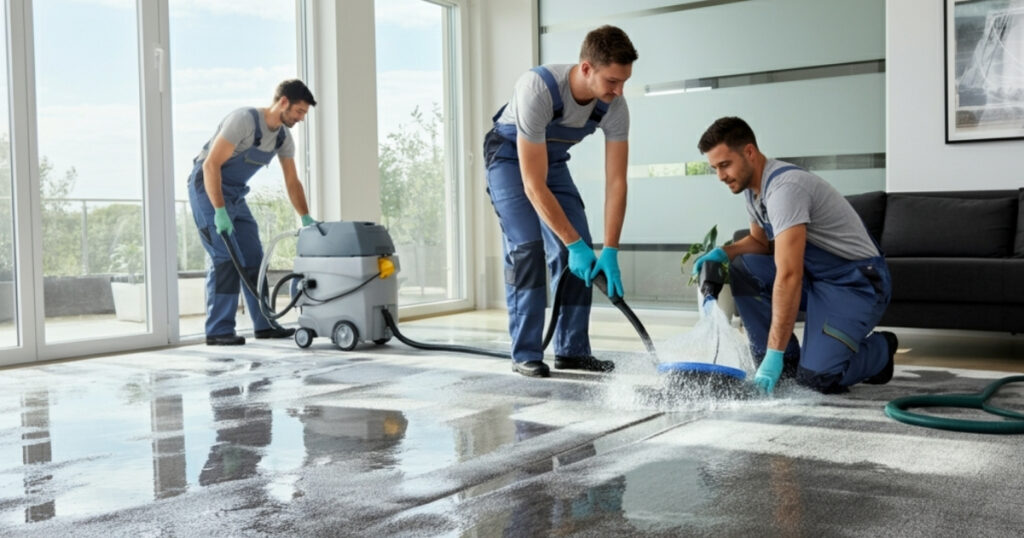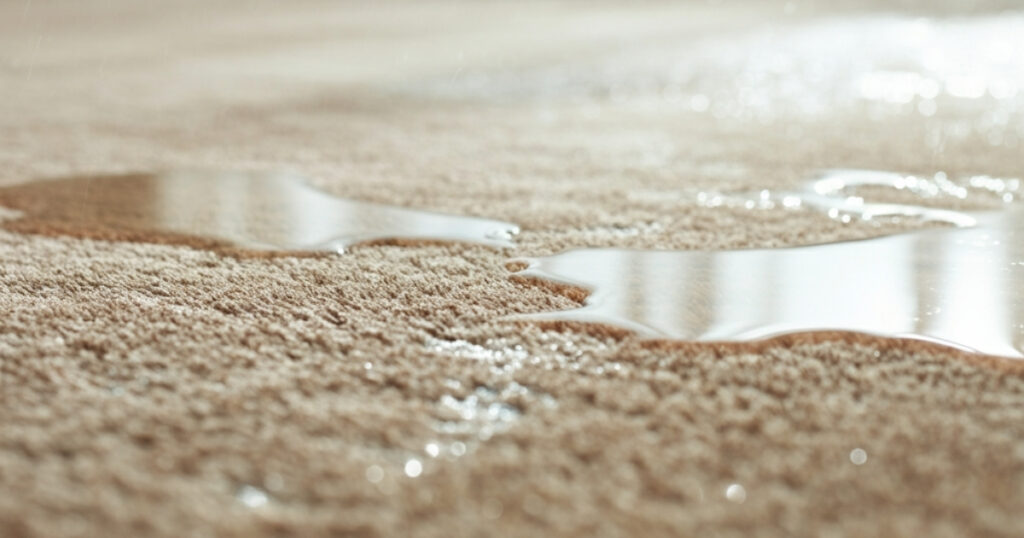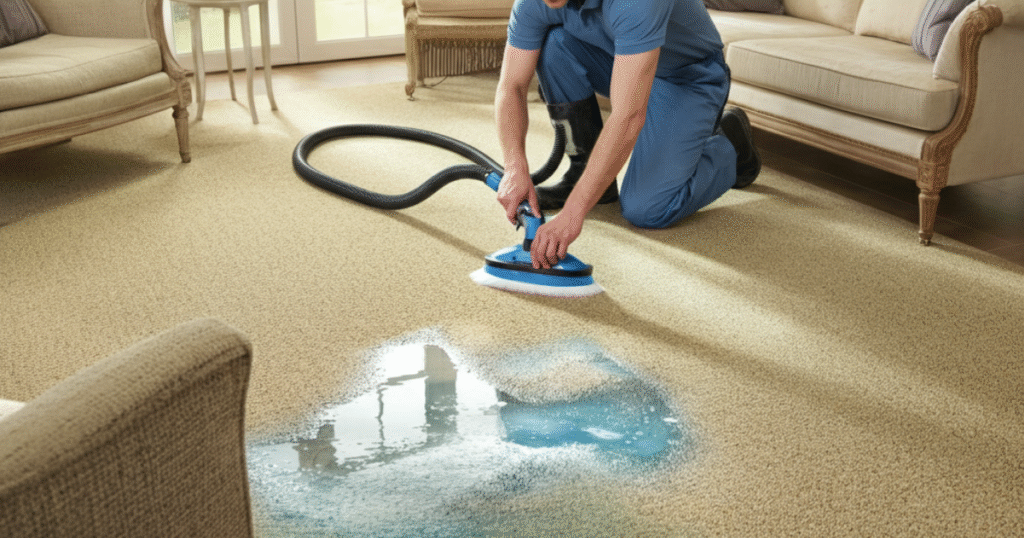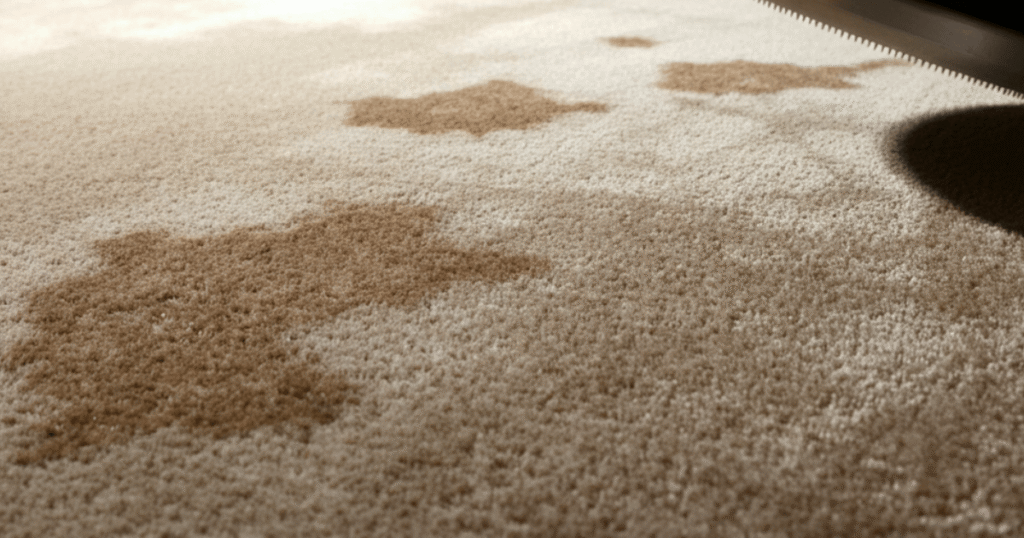Furniture beetles can cause serious damage to wooden furniture and structures if left untreated. If you’re wondering how to get rid of furniture beetles naturally, rest assured, you don’t need harsh chemicals to eliminate these destructive pests. Natural methods offer safe, effective solutions that protect your family while preserving your valuable furniture pieces.
Understanding furniture beetles and their behavior helps you implement targeted natural treatments. These small insects bore into wood, creating tunnels that weaken structural integrity over time. Fortunately, several natural remedies can eliminate infestations without exposing your home to toxic substances.
Understanding Furniture Beetles and Their Behavior
What Are Furniture Beetles
Furniture beetles belong to a family of wood-boring insects that attack both softwood and hardwood pieces. These tiny pests measure between 2-5mm in length and appear brown or black in color. Adult beetles emerge from wood through small, round exit holes that indicate active infestations.
The most common species include common furniture beetles, deathwatch beetles, and powder post beetles. Each species targets different wood types and moisture levels throughout their life cycles. Moreover, these beetles can remain dormant in wood for several years before emerging as adults.
Female beetles lay eggs in wood cracks, crevices, or existing holes after mating occurs. The larvae then bore through wood fibers for 2-4 years before pupating and emerging as adults. Consequently, infestations often go unnoticed until significant damage has already occurred in furniture pieces.
Signs of Furniture Beetle Infestation
Small, round holes approximately 1-2mm in diameter indicate furniture beetle emergence from wood surfaces. Fresh holes appear clean and light-colored, while older holes may darken with age and dust accumulation. Additionally, you might notice fine, powdery frass (beetle droppings) near infected furniture pieces.
Active infestations produce subtle tapping sounds, especially during quiet evening hours when beetles move within wood structures. Furthermore, weakened wood areas may feel soft or spongy when pressed gently with your finger. Therefore, regular inspection helps detect infestations before extensive damage occurs.
Flying beetles around wooden furniture during spring and summer months suggest active breeding populations nearby. These adults seek new wood surfaces for egg-laying, potentially spreading infestations to other furniture pieces. Consequently, prompt action prevents further damage and stops reproductive cycles effectively.
Why Natural Methods Work Better
Natural treatments eliminate furniture beetles without introducing harmful chemicals into your living environment. Chemical pesticides can pose health risks to children, pets, and adults with respiratory sensitivities or allergies. Moreover, natural methods often prove more sustainable and environmentally responsible than conventional treatments.
Many natural substances penetrate wood fibers effectively, reaching beetle larvae hidden deep within furniture structures. Additionally, these treatments don’t leave toxic residues that could affect indoor air quality over time. Therefore, natural approaches provide safe, effective solutions for long-term pest management.
Natural methods also cost less than professional chemical treatments while offering comparable effectiveness against furniture beetle infestations. Furthermore, most natural ingredients are readily available in homes or local stores. Consequently, homeowners can implement treatments immediately without waiting for professional services or specialized products.
Essential Oils That Eliminate Furniture Beetles
Tea Tree Oil Treatment
Tea tree oil contains powerful antimicrobial and insecticidal properties that effectively eliminate furniture beetles and their larvae. Mix 10-15 drops of pure tea tree oil with one cup of water in a spray bottle. Additionally, add a small amount of dish soap to help the mixture adhere to wood surfaces better.
Spray the solution directly onto affected areas, focusing on exit holes and surrounding wood surfaces where beetles might be present. Allow the treatment to penetrate for several hours before wiping away excess moisture with a clean cloth. Furthermore, repeat applications weekly for 4-6 weeks to ensure complete elimination of all life stages.
Tea tree oil’s strong scent also acts as a natural repellent, discouraging adult beetles from laying eggs in treated furniture pieces. Moreover, this essential oil doesn’t damage wood finishes when used in proper dilution ratios. Therefore, tea tree oil provides both treatment and prevention benefits for ongoing furniture beetle management.
Lavender Oil Solution
Lavender oil offers gentle yet effective treatment options for furniture beetle elimination while providing pleasant aromatherapeutic benefits. Combine 20 drops of lavender essential oil with one cup of white vinegar in a spray container. Subsequently, add a teaspoon of liquid castile soap to improve mixture adhesion on wood surfaces.
Apply the lavender solution generously to infected areas using a spray bottle or clean cloth application method. Focus treatment on visible exit holes, cracks, and crevices where beetles typically hide during daylight hours. Additionally, treat surrounding areas to create protective barriers against future infestations.
Lavender’s natural insect-repelling properties help prevent new beetle populations from establishing in treated furniture pieces. Furthermore, this essential oil is safe around children and pets when used as directed. Consequently, lavender treatments provide family-friendly solutions for ongoing furniture beetle management and prevention efforts.
Peppermint Oil Applications
Peppermint oil delivers potent insecticidal effects while creating refreshing scents throughout your home environment. Mix 15 drops of peppermint essential oil with two cups of warm water and one tablespoon of liquid soap. Moreover, ensure thorough mixing before each application to maintain proper ingredient distribution.
Spray the peppermint solution directly onto beetle exit holes and surrounding wood areas using circular motions for even coverage. Allow the treatment to air dry completely before handling furniture pieces or sitting on treated surfaces. Additionally, reapply treatments every 5-7 days for optimal effectiveness against active infestations.
Peppermint’s cooling menthol compounds penetrate wood fibers effectively, reaching hidden larvae within furniture structures. Furthermore, adult beetles avoid areas treated with peppermint oil due to its strong, overwhelming scent. Therefore, peppermint treatments provide comprehensive protection against current and future furniture beetle problems.
Natural Powder Treatments for Beetle Control
Diatomaceous Earth Application
Food-grade diatomaceous earth provides mechanical pest control by damaging insect exoskeletons when contacted directly. Sprinkle fine diatomaceous earth powder into beetle exit holes using a small funnel or squeeze bottle. Additionally, apply thin layers around furniture bases and in nearby cracks where beetles might hide.
The microscopic sharp edges in diatomaceous earth cut through beetle bodies, causing dehydration and eventual death within several days. Moreover, this natural substance remains effective as long as it stays dry and undisturbed. Consequently, diatomaceous earth provides long-lasting protection against various life stages of furniture beetles.
Vacuum treated areas thoroughly after 7-10 days to remove dead beetles and spent diatomaceous earth powder. Furthermore, reapply fresh powder if continued beetle activity is observed in the same locations. Therefore, regular monitoring and reapplication ensure complete elimination of persistent furniture beetle populations.
Borax Powder Solution
Borax acts as a natural insecticide and fungicide that eliminates furniture beetles while preventing wood decay organisms. Mix equal parts borax powder and powdered sugar to create an attractive bait mixture. Subsequently, place small amounts of this mixture near exit holes and beetle activity areas.
The sugar attracts beetles while borax provides lethal effects when consumed by adult insects or larvae. Additionally, borax penetrates wood fibers gradually, creating treated zones that remain toxic to beetles for extended periods. Moreover, this treatment method targets feeding behaviors rather than relying solely on contact applications.
Exercise caution when using borax around children and pets, as ingestion can cause digestive upset or other health concerns. Furthermore, wear gloves and avoid inhaling powder particles during application procedures. Therefore, proper safety measures ensure effective treatment while protecting household members from potential exposure risks.
Baking Soda Treatment
Baking soda disrupts beetle digestive systems while creating alkaline conditions that discourage continued infestations in wooden furniture pieces. Mix three tablespoons of baking soda with one cup of warm water until completely dissolved. Additionally, add several drops of dish soap to improve adherence on wood surfaces.
Apply the baking soda solution using a spray bottle or sponge application method, ensuring thorough coverage of affected areas. Focus treatment on exit holes, cracks, and surrounding wood surfaces where beetle activity has been observed. Furthermore, allow solutions to dry completely before using furniture or handling treated surfaces.
Baking soda treatments work gradually by altering pH levels within wood fibers, creating inhospitable environments for beetle survival and reproduction. Moreover, this household ingredient poses minimal risks to humans and pets when used appropriately. Consequently, baking soda provides safe, accessible treatment options for natural furniture beetle elimination efforts.
Heat and Cold Treatment Methods
Heat Treatment Techniques
Heat treatment eliminates furniture beetles by raising wood temperatures beyond their survival thresholds without damaging furniture finishes or structural integrity. Small furniture pieces can be treated in specialized heating chambers or enclosed spaces with controlled temperature monitoring. Additionally, professional heat treatment services offer comprehensive solutions for larger items or severe infestations.
Target temperatures between 120-140°F (49-60°C) maintained for 2-3 hours effectively kill all beetle life stages within wood structures. However, monitor temperature levels carefully to prevent wood cracking, finish damage, or structural weakening during treatment processes. Furthermore, allow treated pieces to cool gradually before moving or handling to prevent thermal shock damage.
Portable heaters, heat guns, or infrared lamps can provide localized heat treatment for specific furniture areas showing beetle activity. Moreover, this method works particularly well for solid wood pieces without veneer surfaces or delicate finishes. Therefore, heat treatment offers chemical-free solutions when applied correctly with appropriate safety precautions and temperature monitoring.
Cold Treatment Applications
Extreme cold temperatures effectively eliminate furniture beetles by freezing body fluids and disrupting cellular functions within all life stages. Wrap smaller furniture pieces in plastic sheeting and place them in large freezers for 72-96 hours minimum. Additionally, ensure temperatures remain below 0°F (-18°C) throughout the entire treatment period for optimal effectiveness.
Professional freezing facilities offer services for larger furniture pieces that cannot fit in residential freezers or chest freezers. Furthermore, cold treatment works particularly well during winter months in regions with sustained below-freezing temperatures. Consequently, outdoor cold treatment provides cost-effective solutions when natural weather conditions cooperate with treatment timing requirements.
Monitor furniture pieces carefully during cold treatment to prevent condensation damage when returning items to room temperature environments. Moreover, allow gradual temperature adjustment over several hours to prevent wood cracking or finish damage. Therefore, proper cold treatment protocols ensure beetle elimination while preserving furniture integrity and appearance.
Combination Temperature Approaches
Alternating heat and cold treatments can improve effectiveness against particularly stubborn furniture beetle infestations that resist single-method approaches. Begin with heat treatment to stress beetle populations, followed by cold treatment to eliminate weakened survivors. Additionally, this combination approach disrupts beetle life cycles more comprehensively than individual temperature methods alone.
Allow 24-48 hours between temperature treatments to prevent excessive stress on wood fibers and furniture joints or connections. Moreover, monitor furniture closely for signs of damage during combination treatment protocols. Furthermore, this method works best on solid wood pieces without complex joinery or delicate surface treatments.
Professional consultation may be advisable for valuable antique furniture or pieces with uncertain construction methods before implementing combination temperature treatments. Subsequently, expert guidance ensures appropriate treatment selection while minimizing risks of permanent damage to irreplaceable furniture pieces. Therefore, careful planning and professional advice optimize treatment outcomes for high-value furniture collections.
Preventive Measures and Long-term Solutions
Environmental Control Strategies
Maintaining low humidity levels below 60% creates unfavorable conditions for furniture beetle survival and reproduction throughout your home environment. Use dehumidifiers, improve ventilation, and address moisture sources that contribute to elevated humidity around wooden furniture pieces. Additionally, proper climate control prevents wood decay that attracts beetle infestations initially.
Regular cleaning and dusting of furniture surfaces removes potential beetle eggs and eliminates food sources that support larval development within wood fibers. Moreover, vacuum cracks, crevices, and joints thoroughly to remove accumulated debris where beetles might hide or lay eggs. Consequently, consistent maintenance reduces infestation risks significantly over time.
Monitor furniture regularly for early signs of beetle activity, including exit holes, frass deposits, or unusual sounds coming from wooden pieces. Furthermore, inspect new wooden items before bringing them indoors to prevent introducing infected pieces to your existing furniture collection. Therefore, proactive monitoring and careful selection prevent many infestations before they become established problems.
Wood Treatment and Maintenance
Apply natural wood preservatives like linseed oil, beeswax, or mineral oil to furniture surfaces regularly to maintain wood health and create protective barriers. These treatments penetrate wood fibers, making them less attractive to egg-laying female beetles while improving overall furniture durability. Additionally, well-maintained wood resists beetle attack more effectively than neglected or damaged pieces.
Seal cracks, gaps, and joints in wooden furniture using appropriate wood fillers or natural sealants to eliminate hiding places for beetles. Moreover, sand and refinish damaged areas to remove existing beetle tunnels and create smooth surfaces that discourage future infestations. Consequently, proper maintenance eliminates many factors that contribute to beetle establishment and survival.
Store wooden items in dry, well-ventilated areas away from basements, attics, or other moisture-prone locations that encourage beetle activity. Furthermore, maintain consistent temperatures and avoid extreme fluctuations that stress wood and create favorable conditions for pest establishment. Therefore, proper storage and environmental control provide long-term protection for wooden furniture investments.
Natural Repellent Applications
Create natural repellent sachets using dried lavender, cedar chips, or rosemary leaves placed near wooden furniture to discourage beetle activity continuously. Replace sachets every 3-4 months to maintain effectiveness, especially in humid environments where natural materials lose potency more quickly. Additionally, these natural repellents provide pleasant aromas while protecting furniture from various wood-boring insects.
Spray furniture quarterly with diluted essential oil solutions containing cedar, eucalyptus, or citrus oils to maintain protective barriers against beetle infestations. Moreover, focus applications on furniture joints, cracks, and areas with previous beetle activity for enhanced protection. Furthermore, regular repellent applications prevent new infestations while supporting existing treatment efforts effectively.
Plant beetle-repelling herbs like rosemary, lavender, or mint near windows and entrances to reduce adult beetle populations entering your home environment. Subsequently, these plants provide natural landscaping benefits while contributing to integrated pest management strategies. Therefore, combining indoor and outdoor natural repellent approaches creates comprehensive protection systems for wooden furniture collections.
When to Seek Professional Help
Identifying Severe Infestations
Extensive exit hole patterns covering large furniture areas indicate severe infestations requiring professional intervention beyond natural treatment capabilities. Additionally, structural weakening evidenced by soft, crumbling wood or collapsed furniture joints suggests advanced damage needing expert assessment. Moreover, persistent beetle activity despite consistent natural treatment efforts may require professional pest management services.
Multiple furniture pieces showing simultaneous beetle activity throughout your home indicates widespread infestation problems that exceed typical DIY treatment capabilities. Furthermore, valuable antique furniture or irreplaceable family heirlooms deserve professional treatment to prevent accidental damage during elimination efforts. Consequently, professional services provide specialized equipment and expertise for complex or high-value situations.
Historical buildings or homes with structural wooden elements showing beetle damage require professional evaluation to prevent safety hazards or costly repairs. Moreover, professional services can assess overall infestation extent and recommend appropriate treatment strategies for different areas. Therefore, expert consultation ensures comprehensive solutions for serious furniture beetle problems.
Professional Treatment Benefits
Professional pest control services offer specialized equipment like fumigation chambers, targeted injection systems, and monitoring tools unavailable to homeowners. Additionally, trained technicians can identify beetle species accurately and recommend species-specific treatment approaches for optimal effectiveness. Moreover, professional services provide warranties and follow-up treatments to ensure complete elimination.
Expert assessment helps distinguish furniture beetle damage from other wood-destroying insects like termites, carpenter ants, or old house borers. Furthermore, professionals can evaluate whether furniture pieces are worth treating or should be discarded to prevent further spread. Consequently, expert guidance prevents wasted effort on severely damaged or untreatable pieces.
Professional services often combine multiple treatment methods simultaneously for enhanced effectiveness against stubborn infestations. Moreover, they can treat entire homes systematically to prevent reinfestations from untreated areas. Therefore, professional intervention provides comprehensive solutions when natural methods prove insufficient for complete beetle elimination. For a deeper understanding, visit our related post: Why Is Professional Upholstery Cleaning Essential for Your Furniture?
Frequently Asked Questions
1. Can furniture beetles spread to other wooden items in my home?
Yes, adult beetles actively seek new wood surfaces for egg-laying, potentially infesting other furniture pieces, structural timber, or wooden decorations throughout your home.
2. How long do natural treatments take to eliminate furniture beetles completely?
Natural treatments typically require 4-8 weeks of consistent application to eliminate all life stages, as beetle larvae can remain dormant for extended periods.
3. Are natural methods as effective as chemical pesticides for furniture beetle control?
Yes, natural methods can be equally effective when applied consistently and correctly, though they may require longer treatment periods than chemical alternatives.
4. Can I prevent furniture beetles by choosing certain wood types?
Some woods like cedar, teak, and pressure-treated lumber resist beetle attacks naturally, but no wood type is completely immune to infestation.
5. Do furniture beetles bite humans or pets?
No, furniture beetles do not bite humans or pets. They focus exclusively on boring into wood and pose no direct health threats.
6. How can I tell if furniture beetle treatment is working?
Successful treatment shows no new exit holes, absence of fresh frass deposits, and elimination of tapping sounds from wooden furniture pieces.
7. Can I use multiple natural treatments simultaneously for better results?
Yes, combining different natural methods like essential oils with diatomaceous earth often improves treatment effectiveness against furniture beetle infestations.
8. Should I throw away furniture with beetle damage?
Furniture with minor surface damage can often be saved with proper treatment, but severely weakened pieces may require disposal for safety reasons.
Protecting Your Furniture Investment Naturally
Successfully eliminating furniture beetles naturally requires patience, consistency, and proper application of proven methods. Essential oils, natural powders, and temperature treatments provide effective solutions without exposing your family to harmful chemicals.
Regular monitoring and preventive measures help maintain beetle-free environments long-term. Therefore, implementing comprehensive natural strategies protects your wooden furniture while preserving indoor air quality and family health effectively. If you’re curious to learn more, check out this article: How to Protect Leather Furniture from Cats?
As an Amazon Associate, I earn from qualifying purchases.



